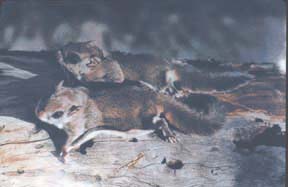Silent Flyers Glide Through Our Forests
By Kathy Reshetiloff
Recently I discovered that crickets, toads and bats aren't the only night time visitors to my backyard. Letting my dog out one evening, I was startled by a small animal hanging on my bird feeder. Caught in the glare of the porch light, the small mammal stood motionless. Then in an instant it leaped, gliding silently off my deck to the woods below.
 This nighttime raider was a southern flying squirrel (Glaucomys volans). Although they are found in woods from southern Ontario to the Gulf Coast, southern flying squirrels are not commonly seen, due to their stealth-like nocturnal habits. Only 8-10 inches long, that's including the tail, southern flying squirrels are grayish to brown above and creamy white below with a flattened tail, large ears and large black eyes. This nighttime raider was a southern flying squirrel (Glaucomys volans). Although they are found in woods from southern Ontario to the Gulf Coast, southern flying squirrels are not commonly seen, due to their stealth-like nocturnal habits. Only 8-10 inches long, that's including the tail, southern flying squirrels are grayish to brown above and creamy white below with a flattened tail, large ears and large black eyes.
Of course, the most notable feature is the thin, furry membrane of skin, known as a patagium, which runs along the sides of the body from the wrist of the front leg to the ankle of the hind leg. This membrane is what gives the squirrel its flying or, more accurately, its gliding ability.
When the front and back legs are extended, the membrane forms a wing-like gliding surface, acting like a parachute while the flat tail serves as a rudder. This allows the squirrel to glide silently from tree to tree. Before landing, the squirrel drops its tail and lifts its front legs. This slackens the membrane and acts as a brake. Flying squirrels land as lightly and quietly as they glide and will immediately scurry to the other side of a tree trunk to avoid detection by predators.
There are two breeding periods for the southern flying squirrel. The first is February through March and the second is May through July. Litters average between three and four young born hairless with eyes and ears closed, weighing less than ¼ of an ounce. Development is slow. Ears open at three weeks; eyes open at four. The young are weaned by six to eight weeks and then are capable of gliding. The females, devoted mothers seldom leave their newborns, defending them and even moving them if the nest is disturbed.
Southern flying squirrels favor beech-maple, oak-hickory and live oak forests. Tree cavities serve as nest sites. Often squirrels will use one cavity as their nesting site and others as feeding or refuge areas. Not surprisingly, their primary foods include nuts such as acorns and hickory nuts, but they will also eat berries, seeds, fruits, buds, flowers, mushrooms and bark.
As the days shorten, flying squirrels will begin hoarding food. Nuts are gathered and stored, either buried individually or stashed in nest cavities or cracks and crevices of trees. They do not hibernate, but may remain in nests for several days during severe weather. Groups of flying squirrels may gather in one cavity to conserve warmth.
Predators include cats, owls, hawks, raccoons, weasels and foxes. However, the amount and quality of habitat is probably the biggest threat these squirrels face. Southern flying squirrels require forests with mast (nut) producing trees and cavities for nesting.
The Chesapeake Bay watershed was covered by forests when colonists first arrived. Since then forests have been fragmented, cleared piece by piece, to make room for roads, businesses, farms and homes. Between 1985 and 1995, 471,000 acres of forests, about half the size of Delaware, have been lost. The Chesapeake Bay watershed continues to lose about 100 acres of woodlands a day. In many places only small disconnected patches remain.
Efforts are underway to conserve remaining forests and reconnect patches of forests. Conservation of remaining forests, as well as forest restoration, benefits not only small woodland creatures like the flying squirrel, but the entire Chesapeake Bay watershed and all of us who live here.
Back
|

